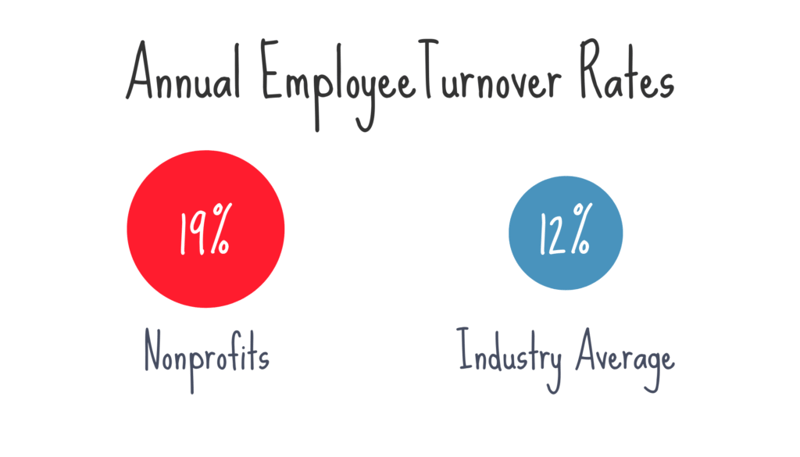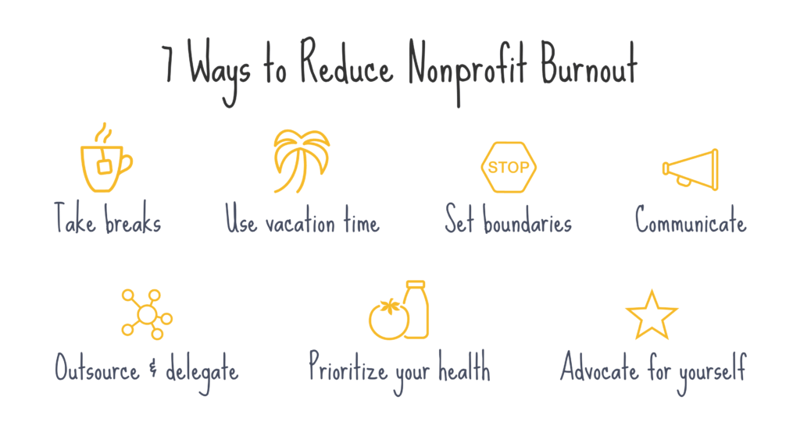Let’s talk burnout: the nonprofit sector is well acquainted with this workplace phenomenon. Organizations like yours tackle big issues, and you and your volunteers work hard to make real change in your communities. But what happens when the nonprofit work you’re passionate about leads to unmanageable stress?
Burnout is a real concern for nonprofit employees, volunteer leaders, and even volunteers. We’ll help you recognize the signs of nonprofit employee burnout and volunteer burnout while outlining strategies to help you catch it before it becomes a problem.
Article Contents:
a. Nonprofit Burnout: The Basics
c. How to Prevent Nonprofit Employee Burnout

Nonprofit Burnout
Nonprofits are under a lot of pressure to deliver essential services, often on tight budgets. This pressure pile up can lead to burnout, a serious condition that impacts nonprofits and their employees.
In this section, we’ll discuss:
- How to identify burnout in volunteer leaders and nonprofit employees
- How to prevent burnout in volunteer leaders and nonprofit employees
- How to cope if you’re feeling burnt out
Nonprofit Burnout: The Basics
To combat burnout, we’ll first define burnout and discover its warning signs:
What is nonprofit burnout?
Burnout is a phenomenon resulting from work-related stress. It’s important to note that occupational burnout is a syndrome recognized by the World Health Organization (WHO). Burnout can cause real psychological and physical symptoms and should be taken seriously by employers and employees alike.
WHO provides this general definition:
Burnout is a phenomenon “resulting from chronic workplace stress that has not been successfully managed.”
Nonprofit burnout occurs when employees endure unmanaged stress related specifically to their nonprofit occupation. Nonprofit burnout causes many of the same symptoms as general occupational burnout.
What are nonprofit burnout symptoms?
Nonprofit employee burnout usually results in three main “warning signs”:
- Inefficacy
- Cynicism
- Exhaustion
Employees may also experience specific physical or emotional symptoms as a result of burnout, including:
- Reduced participation or reliability
- Lack of productivity
- Loss of enjoyment or interest
- Increased irritability or anger
If you notice a coworker feeling overwhelmed, anxious, or depressed, consider referring to this Healthline guide.
What Causes Nonprofit Burnout?
Nonprofits are often confronted with high expectations and significant pressure to succeed from many angles. Relying on grants and contributions to produce big results, they’re consistently faced with tough choices about how they spend their limited time and money.
So, to protect the quality or scope of services, nonprofits sometimes look to cut costs internally. Nonprofit employees are passionate about what they do, making them more willing to push through workplace stress until it becomes unmanageable. Being part of any nonprofit team can, at times, feel like trying to sprint through a marathon.
It’s a cycle that leads to what many experts call “nonprofit burnout culture.”
While the causes of prolific nonprofit burnout tend to be complicated and systemic, there are incremental changes employers and employees can make to curb nonprofit burnout.
Why should nonprofits care about employee burnout?
Burnout can cause real physical, psychological, and emotional issues in its sufferers. Severe cases can lead to anxiety and depression, and other serious stress-related health concerns.
What’s more, burnout is a major contributing factor to the nonprofit sector’s employee turnover problem.
At 19%, the nonprofit industry experiences some of the highest employee turnover rates, well above the industry average (12%). A new report from NonprofitHR found that 43% of nonprofit employees will be looking for new jobs in the next five years.

Hiring new talent is expensive, a challenge for social impact organizations already strapped for resources. A report from The Center for American Progress found that hiring and training a new employee can cost anywhere from 16% of an employee’s salary (for hourly workers) to 213% of leadership role wages.
Burnout is not only cost-inefficient; it’s crippling for nonprofit employers and employees.
How to Manage Your Burnout
Burnout is a common phenomenon among nonprofit workers and volunteer leaders. Whether you’re a volunteer leader experiencing burnout yourself or looking to reduce burnout in your employees, it’s essential to take steps to prevent burnout from happening in the first place.
Here’s how to take matters into your own hands to manage your burnout:
Take Breaks
Studies show that productivity can increase when employees take short, regular breaks throughout the workday. Go for a walk, grab a coffee, take a few deep breaths, and return when you’re ready.
Use Your Vacation Time
If you have vacation time, use it! Small breaks are helpful in the short-term, but you’ll also need a longer break (even a staycation!) to reset. If you don’t have vacation time, advocate for it. The cost-benefit of employee vacation time significantly outweighs the cost of burnout.
Set Firm Work Boundaries
Set limits to your workday. Leave your work at work when you head home for the evening or weekend. Make a list of priorities for your week. That way, if you don’t get to everything on your list, at least you’ve accomplished the most important tasks first. If a manager asks you if you can take anything else on, be honest and realistic about your schedule. It’s okay to say no!
Outsource and Delegate
You’re passionate about the work you do, but you can’t take it all on yourself. Seek help and trust in others to share the workload. Hint: interns and volunteers are a great resource!
Prioritize Your Health
If you’re already feeling stressed, take a step back, and assess your physical and mental wellbeing. Find healthy ways to relax, like yoga or coffee with friends. Remember that self-care is essential, but it’s also not the all-purpose cure for burnout.
Advocate for Your Worth
You work hard. You have bills to pay. Don’t be afraid to ask for that raise you think you deserve. Come prepared with data, anecdotes, and results-driven evidence that will appeal to your manager. Many employees don’t get what they need because they don’t ask. You’re your own advocate.
Communicate with Your Manager
Your manager or boss probably isn’t a mindreader. If you notice stress-inducing workarounds, communicate them. If you feel burnout coming on, call a meeting to discuss directly. The longer you continue to “deal with it” yourself, the worse burnout can become. Remember, the problem tends to be with the organization, not the individual.

How to Prevent Nonprofit Employee Burnout
The following strategies are directed toward nonprofit professionals who want to help reduce employee burnout. Large systemic solutions (like company-wide culture shifts) will likely require a long series of audits and approval from higher-ups. But there are simple, cost-effective strategies nonprofit managers can employ to reduce employee burnout:
Encourage Feedback
You’re probably used to providing your employees with feedback, but when’s the last time you invited feedback from them? Having open conversations can encourage a healthy dialogue. Send out anonymous surveys and ask employees to share their honest thoughts.
Empower and Engage Employees
Empower employees to become a part of the solution. Find ways to engage employees in problem-solving initiatives, like an internal committee about policy issues. Employees want upward mobility. Wherever you can, invite opportunities for growth and leadership. Show that you’re invested in their success.
Make Life Just a Bit Easier
Small, inexpensive changes can make a big deal to your employees. Provide breakfast or wellness vouchers, organize carpool or dry cleaning, encourage breaks, and generally strive to be understanding of your employees’ daily needs.
Switch Up the Schedule
Employees cite inflexible work schedules as one of the main reasons they quit the nonprofit sector. If you can, encourage some flexibility and offer a reprieve from schedules chock-full of meetings. Keep weekly meetings succinct and invite independent time for strategic and creative thinking. Sometimes the most productive days are “unscheduled.”
Be an Advocate
Nonprofit professionals, from the part-time employee to the board, have many people to answer to. Maybe you can’t directly award salary increases or additional time off, but your staff needs an advocate willing to go to bat for them. If you see an issue, collect data, and raise it with the appropriate party. Staff is willing to put in the time for you, and it’s important they feel it’s reciprocated.

Volunteer Burnout
We’ve discussed nonprofit employee burnout. But did you know that volunteers can experience burnout too?
Volunteers are a hard-working bunch; they’re willing to put in their time without financial reward, and our communities have come to rely on their goodwill. But over time, volunteers can become overwhelmed by the work to the point where volunteering becomes unmanageable.
Volunteer Burnout: The Basics
Are your volunteers experiencing burnout? If so, how do you recognize it? Let’s review the basics of volunteer burnout.
To understand volunteer burnout, we’ll refer to WHO’s definition of occupation burnout provided earlier in the article:
Burnout Definition – A phenomenon resulting from chronic workplace stress that has not been successfully managed.
Unlike occupational burnout, volunteer burnout is not a classified syndrome or medical condition. If you suspect a volunteer is experiencing symptoms, you may suggest they seek professional guidance.
What causes volunteer burnout?
Volunteer burnout is usually caused by stress related to volunteering conditions. Volunteers may exhibit similar signs of burnout as a result of external conditions (like home life). But volunteer burnout results directly from the volunteers’ experience performing volunteer work or interacting with your organization.
Don’t despair if you think your volunteers are feeling burnt out. Here’s some good news: the more you learn about burnout, the better equipped you’ll be to alleviate and prevent it.
Common causes of volunteer burnout:
- Lack of volunteer role clarity
- Lack of support and communication from the volunteer leader or supervisor
- Unmanageable volunteer workload or schedule
- Unfair treatment by managers or other volunteers
Why do volunteers quit?
Volunteer professionals often cite volunteer burnout as one of the leading causes of low volunteer retention. Volunteers are more likely to quit because they’re feeling burnt out or overcommitted, especially after the initial feelings of enthusiasm subside. The longer a volunteer participates with your organization, the more likely they are to quit due to burnout.
Want to learn more about volunteer management? Check out our getting started guide here.
Why should organizations prevent volunteer burnout?
Volunteer burnout can influence the overall impact of your organization. Many volunteers fill public-facing roles and provide essential services to clients. Stressed or disheartened volunteers can negatively affect the clients in need of your services.
Nonprofits should strive to identify and address volunteer burnout warning signs to reduce volunteer turnover and, more importantly, avoid compounding burnout symptoms in volunteers.
How to Prevent Volunteer Burnout
Often, volunteers and employees are left to resolve burnout themselves. However, according to Harvard Business Review, the responsibility should fall mainly on the organizations and workplaces to take action and prevent burnout. Your volunteers work selflessly to make a change in your community, but they shouldn’t pay the price in psychological, emotional, or physical wellbeing.
Preventing burnout is about continuously supporting your volunteers.
Here are some tried and true strategies for preventing volunteer burnout:
Set Clear Expectations
Provide volunteers with clear role descriptions and communicate expectations before the volunteer begins work. How much time are you asking your volunteers to commit? What role-specific challenges should volunteers be aware of?
These expectations should be communicated during the volunteer recruitment phase. Volunteer training is also a great time to prepare volunteers for their roles.
Honest communication between the organization and the volunteer supports role clarity and alignment of expectations. Setting clear expectations is especially important if the volunteer work is emotionally taxing or requires a significant time commitment.
Understand Why People Volunteer
For volunteers to do their best work, they need (1) the necessary tools and resources to accomplish the volunteer work and (2) sustained motivation throughout their volunteering experience.
Naturally, green volunteers are energetic and enthusiastic about your cause. But motivation can decrease with time. To sustain volunteers’ motivation, nonprofit professionals must work continuously to inspire and reinspire their volunteers.
But what keeps volunteers coming back and doing great work?
According to motivation theory, volunteers tend to fall into three categories:
- Affiliation-Motivated Volunteers: This volunteer prefers social interaction and likes to get involved with group activities. They may volunteer because others are doing so or to make friends. This volunteer wants others to perceive them as a “good” person.
- Achievement-Motivated Volunteers: This volunteer is motivated by specific goals. They seek responsibility and like to take on challenges.
- Power-Motivated Volunteers: This volunteer wants to impact and influence others. They tend to be driven by specific causes and want to directly relate to your organization’s overall goal.
Of course, volunteers can be motivated by any number of factors. As part of your program’s volunteer management and retention strategy, look for unique ways to re-energize a diverse array of volunteers.
Consider Volunteers’ Skills and Interests
Volunteers are less likely to experience burnout when they feel their time and skills are continuously used effectively. One of the best ways to establish this culture early on is to match volunteers with the right opportunity according to their skills and passions.
A volunteer management tool can help you capture volunteer interests and skills and automate the opportunity matching process, ultimately saving you time and money.
Prepare Your Volunteers
Plan a robust volunteer orientation and training programs. Onboarding and training supply your volunteers with the knowledge and tools needed to succeed.
Organizations should take the time to implement engaging volunteer training to boost their volunteer recruitment and retention efforts.
Prepared volunteers make for happy volunteers. Plus, training goes a long way in reducing the initial stress of taking on new challenges.
Communicate Often
Communication is the key to preventing volunteer burnout. Communication can take many forms. Whether you prefer to email, call, or chat in-person, whichever way you choose to connect with your volunteers, make sure you’re doing so regularly.
You may decide to conduct your check-ins by way of a volunteer satisfaction survey. You may also choose to sit down one-on-one, particularly with your experienced volunteers. Regardless, invite constructive discussion by asking thoughtful, volunteer-centric questions.
Here are some meaningful questions to ask your volunteers during check-in:
- How do you feel about your volunteer work?
- Do you feel your volunteer work is important?
- Do you feel your role has changed? In what ways?
- How are you managing your volunteer schedule? Are we asking too much from you? Too little?
Role clarity can decrease over time, and questions like these will also help you identify whether your volunteers feel uncertain in their work.
Listen and Learn from Your Volunteers
Once you invite feedback from your volunteers, be open to listening to their responses. It can be tempting to become defensive when a volunteer expresses a concern. But when you resist the temptation to push back, you can learn a lot about what’s important to your volunteers.
If you really want to understand where your volunteers are coming from, why not join them at their next shift? “Management by wandering around” is a leadership technique that enables managers to gain first-hand insight into the challenges and frustrations that employees or volunteers face while performing their work.
You may learn that they simply want a better way to track their impact or simpler self-scheduling. Perhaps you can’t make large systemic changes immediately, but you can begin by taking incremental actions to curb burnout.
Provide Leadership and Learning Opportunities
Like anyone, your volunteers can become discouraged when they feel powerless. They’re on the ground, experiencing the day to day operations. But do they have an avenue for reporting operational issues when they arise?
One of the best ways to reduce volunteer burnout is to give them a voice. Invite volunteers to join a leadership team to address the everyday challenges volunteers face. Being a part of the solution can turn jaded volunteers into inspired agents of progress.
Remember, burnout can also occur if a volunteer schedule is unmanageable. Piling on more responsibility can jeopardize progress. Ask volunteers if they would like to take on more responsibility before giving it to them.
Express Gratitude and Recognize Achievement
Most of your volunteers want to take part because they believe they can make a real difference. But they may be dealing with deep systemic problems that simply can’t be fixed overnight. When outcomes are slow to reveal, volunteers can become disheartened.
The solution here is simple.
Volunteer appreciation and recognition can go a long way in reinspiring downcast supporters. Recognize milestones, like hours logged or months served. Celebrate small successes. Remind your volunteers that seemingly incremental improvements can make a real difference in someone’s life.
Volunteers are people, not resources. Treat your volunteers with compassion and thank them for their hard work and time.
The nonprofit sector has a lot of work to do to reduce burnout and improve turnover. Much of this change has to come from the top. But there are steps that volunteer leaders and nonprofit managers can take to curb burnout.





